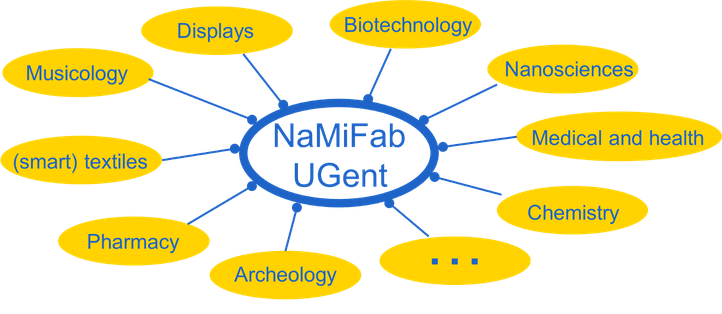About NaMiFab UGent
NaMiFab is a core facility at Ghent University, specialised in Nano-and Microfabrication. Our expertise and instruments are used to structure and combine different materials at nano- and microscale to fabricate various components and systems.
Our mission
for the entire UGent research community working in diverse domains.
With NaMiFab we bring together the processing equipment and expertise of 3 UGent research groups:
- Photonics Research Group (PRG)
- Centre for Microsystems Technology (CMST)
- Liquid Crystals and Photonics Group (LCP)
The available knowhow is widely applicable in diverse domains. Therefore it is relevant for a very broad group of users within Ghent University. The aim of NaMiFab is to make this infrastructure available to the whole UGent research community.
UGent researchers can collaborate with NaMiFab to conduct interdisciplinary research in a wide variety of research domains.
Download our NaMiFab UGent presentation here (pdf, 3MB, 30 slides)
NaMiFab research groups
More information on the research topics of the NaMiFab groups can be found on their individual group pages.
Photonics Research Group (PRG)
PRG uses the infrastructure for realizing photonic integrated chips (PICs). The group carries out research towards the improvement of the processes for realizing these chips as well as uses the fabricated chips for research towards their application in telecom, datacom, biosensing, neural networks etc.
Centre for Microsystems Technology (CMST)
CMST uses the infrastructure for development of new technologies for on one hand electronic/photonic/microfluidic chip packaging and interconnection, in
applications where miniaturisation is required, and on the other hand, for large area electronics and sensor systems, where dynamic and thermoplastic deformability of the circuit is an important research topic.
Liquid Crystals and Photonics Group (LCP)
LCP uses the infrastructure for the realization of liquid crystal devices for research purposes or for proof-of-concept devices. Applications of such devices cover a wide area ranging from optical shutters, optical beam steering devices and tunable lenses to tunable PICs. Next to that also devices with thin organic layers are fabricated in the clean room such as Organic Light Emitting Diodes (OLEDs) and organic solar cells.
